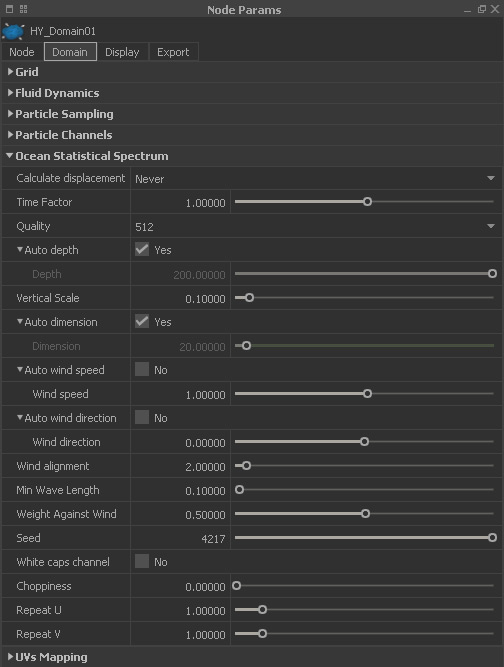HyDomain - Ocean Statistical Spectrum
This adds a wave structure to a meshed Hybrido fluid – also known as “displacement”. Applying Hybrido's displacement requires a certain → workflow.
Calculate displacement
There are three options:
“Never” does not calculate the ocean statistical spectrum information.
“Always” is used when you want to add the displacement to the core fluid simulation.
“Use cache” is required when you to proceed with splash, foam or mist passes. The already simulated displacement will be kept and prevented from unwanted changes.
Time factor
Values greater than 1.0 will accelerate the waves, while values smaller than 1.0 can be used to decelerate them. The advantage is that the waves' speed can be adjusted without changing any other parameter. “Time factor” is dimensionless and works like a multiplier.
Quality
The displacement information is stored as a sequence of files and a “Quality” level of 4096 creates a squared image with 4096 x 4096 pixels, for example. In many cases, a level of 512 or 1024 is enough.
Auto depth
The influence of the fluid's water depth is normally very subtle, but affects the dispersion of the waves. When active, RealFlow calculates the fluid's water depth automatically.
Depth
The effect of this parameter is only noticed if the length of a wave is close to “Depth”. In these cases you will see a decelerating effect on the wave's dispersion. The unit is metres.
Vertical Scale
This is the wave's maximum height. You normally have to adjust this parameter when you are changing the surface’s “Dimension” value.
Auto dimension
Here, the horizontal dimensions of the fluid surface is determined automatically.
Dimension
With 200, the distribution and scale of the waves will look as if the domain covers an area of 200 m x 200 m:
Level of detail [m] = Dimension [m] : Quality
Let’s assume you have created a surface with a “Quality” of 1024 and a “Dimension” of 400 m. The smallest structures you can observe is
400 m (Dimension) : 1024 (Resolution) = 0.39 m
The parameter is given in metres. When you change “Dimension” you will most probably have to modify “Vertical Scale” and “Choppiness”.
Auto wind speed
RealFlow automatically calculates the used wind speed when this parameter is turned on.
Wind speed
You can enter any positive or negative value, including 0. “Wind speed” has a strong influence on the wave's look. Good values are between 20 m/s and 30 m/s.
Auto wind direction
When enabled RealFlow will align the wave's motion with the scene's → “Wind” daemons.
Wind direction
This is the wind direction in degrees – positive wind directions are counter-clockwise:
- 0°: wind comes from the positive X axis.
- 90°: wind comes from the positive Z or Y axis depending on your → axis setup.
- The direction of existing “Wind” daemons is taken into account.
Wind alignment
When “Wind alignment” is increased, RealFlow will remove more and more waves – waves which are less perpendicular to the wind direction.
Min Wave Length
Higher values flatten the surface and create fewer ripples. With small “Dimension” values this parameter should be decreased (e.g. to 0.01 or 0.02) in order to get enough detail.
Weight Against Wind
This parameter ranges between 0 and 1. With
- 0 all waves against the wind are eliminated
- 1 the amount of waves is not influenced.
Seed
By changing this value you are able to change waves' initial distribution. All positive and negative integers are accepted.
White caps channel
This feature adds an Alpha channel to the displacement maps and mimics foamy areas at the waves' crests. White caps can significantly increase simulation times.
Choppiness
This parameter determines the sharpness of the surface waves. High values might create unwanted effects, such as self-intersecting areas. In most cases, values between 0.5 and 1.0 are used.
Repeat U
Displacement maps are seamless and can be tiled with this option. High settings create regular wave patterns.
Repeat V
Displacement maps are seamless and can be tiled with this option. High settings create regular wave patterns.
